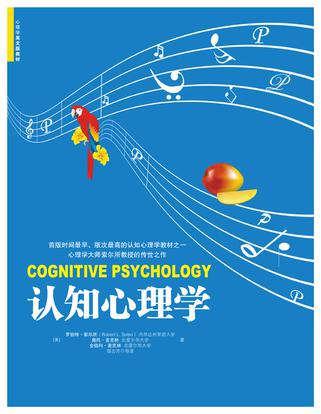章节目录
导读 前言 术语表 第1章 导言与研究方法 3 1.1 何为认知心理学 4 1.2 认知心理学简史 7 1.3 认知心理学是关于信息加工的学问 12 1.4 认知隐喻、认知模型、理论与观点 12 1.5 认知心理学与认知科学的关系 22 1.6 研究方法 25 1.7 致学生 31 第2章 认知神经科学 37 2.1 对脑的探索:最近的前沿 38 2.2 工作日志:21世纪—脑科学 39 2.3 中枢神经系统 42 2.4 发现皮层功能 49 2.5 双半球记 55 2.6 认知神经科学 61 2.7 认知心理学与认知神经科学 62 2.8 神经科学工具箱 63 第3章 感觉、知觉与注意 76 3.1 计算式大脑 77 3.2 感觉与知觉 78 3.3 知觉广度 88 3.4 视像存储 89 3.5 声像存储 90 3.6 感觉存储的功能 92 3.7 注意 93 3.8 加工容量与选择性注意 97 3.9 听觉信号 98 3.10 选择性注意的模型 100 3.11 视觉注意 106 3.12 自动加工 108 3.13 注意的认知神经科学 110 第4章 模式识别 120 4.1 知觉理论 122 4.2 视觉模式识别 125 4.3 格式塔理论 127 4.4 典型视角 130 4.5 自下而上与自上而下加工 133 4.6 模板匹配 135 4.7 特征分析 141 4.8 原型匹配 144 4.9 专家的模式识别 149 4.10 模式识别—知觉者的角色 151 第5章 记忆模型与短时记忆 158 5.1 记忆的二元模型 159 5.2 短时记忆 164 第6章 记忆理论与长时记忆 181 6.1 长时记忆的局部定位与整体分布 182 6.2 长时记忆的容量 183 6.3 长时记忆的保持 185 6.4 长时记忆的储存 192 6.5 记忆的类型 203 6.6 认知神经科学的支持 206 第7章 遗忘与识记 214 7.1 历史的回顾 215 7.2 遗忘理论 216 7.3 记忆错误 221 7.4 识记 223 7.5 增强记忆的因素 223 7.6 超凡记忆 229 第8章 意识 237 8.1 意识的历史 239 8.2 意识的框架:AWAREness理论 240 8.3 意识的功能 246 8.4 意识状态 249 8.5 意识的模型 254 8.6 自动加工 257 第9章 知识的言语表征 270 9.1 语言与知识 271 9.2 联想主义理论 271 9.3 知识的语义组织 272 9.4 命题网络 279 9.5 认知神经科学的支持 283 9.6 联结主义与知识的表征 285 第10章 知识的视觉表征 293 10.1 历史的回顾 294 10.2 关于知识的视觉表征的理论 295 10.3 认知神经科学的支持 303 10.4 认知地图 308 10.5 联觉:颜色的声音 313 第11章 语言 321 11.1 单词及其含义 322 11.2 语言学层级 323 11.3 转换语法 326 11.4 心理语言学 329 11.5 语言与神经学 331 11.6 阅读 332 11.7 词汇决策任务 339 11.8 认知神经科学的支持 342 11.9 理解 343 11.10 一个有关文本理解的模型 348 第12章 认知的毕生发展 357 12.1 认知发展 358 12.2 认知神经发展 369 12.3 认知能力的发展 374 12.4 认知与老化 389 12.5 认知神经科学的支持 391 第13章 概念形成、逻辑和决策 399 13.1 概念形成 400 13.2 逻辑 403 13.3 决策 413 13.4 决策和理性 426 第14章 问题解决,创造力和人类 智力 433 14.1 问题解决 434 14.2 创造 444 14.3 智力 455 第15章 人工智能 475 15.1 历史的回顾 478 15.2 思考的机器 488 15.3 知觉和人工智能 491 15.4 语言和人工智能 498 15.5 问题解决、玩游戏和人工智能 506 15.6 人工智能和艺术 510 15.7 机器人 514 15.8 人工智能的未来 516 15.9 人工智能与科学研究 518 参考文献 523 Contents Chapter 1: Introduction and Research Methods 3 What Is Cognitive Psychology? 4 The History of Cognitive Psychology in Brief 7 Cognitive Psychology Is about Processing Information 12 Cognitive Metaphors, Models, Theories, and Perspectives 12 The Relationship between Cognitive Psychology and Cognitive Science 22 Research Methods 25 To the Student 31 Chapter 2: Cognitive Neuroscience 37 Exploring the Brain: The Frontier Within 38 Logbook: The Twenty-First Century—Brain Sciences 39 The Central Nervous System 42 Discovering Cortical Functioning 49 A Tale of Two Hemispheres 55 Cognitive Neuroscience 61 Cognitive Psychology and Cognitive Neuroscience 62 The Neuroscientists?Toolbox 63 Chapter 3: Sensation, Perception, and Attention 76 The Computational Brain 77 Sensation and Perception 78 Perceptual Span 88 Iconic Storage 89 Echoic Storage 90 Function of Sensory Stores 92 Attention 93 Processing Capacity and Selective Attention 97 Auditory Signals 98 Models of Selective Attention 100 Visual Attention 106 Automatic Processing 108 The Cognitive Neuroscience of Attention 110 Chapter 4: Object Recognition 120 Perceptual Theories 122 Visual Pattern Recognition 125 Gestalt Theory 127 Canonic Perspectives 130 Bottom-Up versus Top-Down Processing 133 Template Matching 135 Feature Analysis 141 Prototype Matching 144 Pattern Recognition among Experts 149 Object Recognition—The Role of the Perceiver 151 Chapter 5: Memory Models and Short-Term Memory 158 Dualist Models of Memory 159 Short-Term Memory 164 Chapter 6: Memory Theories and Long-Term Memory 181 Localization and Distribution of LTM 182 Capacity of LTM 183 Duration of LTM 185 LTM Storage 192 Types of Memory 203 Cognitive Neuroscience Support 206 Chapter 7: Forgetting and Remembering 214 Historical Perspective 215 Theories of Forgetting 216 Memory Errors 221 Remembering 223 Factors that Enhance Memory 223 Extraordinary Memories 229 Chapter 8: Consciousness 237 History of Consciousness 239 Framework for Consciousness: AWAREness 240 Functions of Consciousness 246 States of Consciousness 249 Models of Consciousness 254 Automatic Processes 257 Chapter 9: The Verbal Representation of Knowledge 270 Language and Knowledge 271 Associationist Approach 271 Semantic Organization of Knowledge 272 Propositional Networks 279 Cognitive Neuroscience Support 283 Connectionism and the Representation of Knowledge 285 Chapter 10: The Visual Representation of Knowledge 293 Historical Perspective 294 Theories of the Visual Representation of Knowledge 295 Cognitive Neuroscience Support 301 Cognitive Maps 308 Synesthesia: The Sound of Colors 313 Chapter 11: Language 321 Words and Their Associated Meanings 322 Linguistics Hierarchy 323 Transformational Grammar 326 Psycholinguistics 329 Language and Neurology 331 Reading 332 Lexical-Decision Task (LDT) 339 Cognitive Neuroscience Support 342 Comprehension 343 A Model of Text Comprehension 348 Chapter 12: Cognition across the Lifespan 357 Cognitive Development 358 Neural Development 369 Development of Cognitive Abilities 374 Cognition and Aging 389 Cognitive Neuroscience Support 391 Chapter 13: Concept Formation, Logic, and Decision Making 399 Concept Formation 400 Logic 403 Decision Making 413 Decision Making and Rationality 426 Chapter 14: Problem Solving, Creativity, and Human Intelligence 433 Problem Solving 434 Creativity 444 Human Intelligence 455 Chapter 15: Artificial Intelligence 475 Historical Perspective 478 The Thinking Machine 488 Perception and AI 491 Language and AI 498 Problem Solving, Game Playing, and AI 506 AI and the Arts 510 Robots 514 The Future of AI 516 AI and Scientific Inquiry 518 References 523
内容简介
本书是一部经典的认知心理学教材,涵盖了感觉、知觉、注意、记忆、意识、知识表征、概念形成、推理、决策、问题解决、创造、人类智力、语言、认知以及人工智能等知识概念。其主要的特点是,注重从宏观上叙述和思考认知心理学的理论、模型、实验以及实际应用,并在许多地方提出了所述领域值得进一步研究的问题,很值得读者细心玩味。
下载说明
1、认知心理学是作者罗伯特·索尔所 Robert L. So创作的原创作品,下载链接均为网友上传的网盘链接!
2、相识电子书提供优质免费的txt、pdf等下载链接,所有电子书均为完整版!
下载链接
热门推荐
- 1 独腿旅行者
- 2 人间正道
- 3 野兽必死
- 4 森林中有许多酒
- 5 鲁迅传
- 6 动物园长夫人
- 7 不再努力成为另一个人
- 8 热爱生活的一万个理由
- 9 专家的窘境
- 10 艺术的旅程

